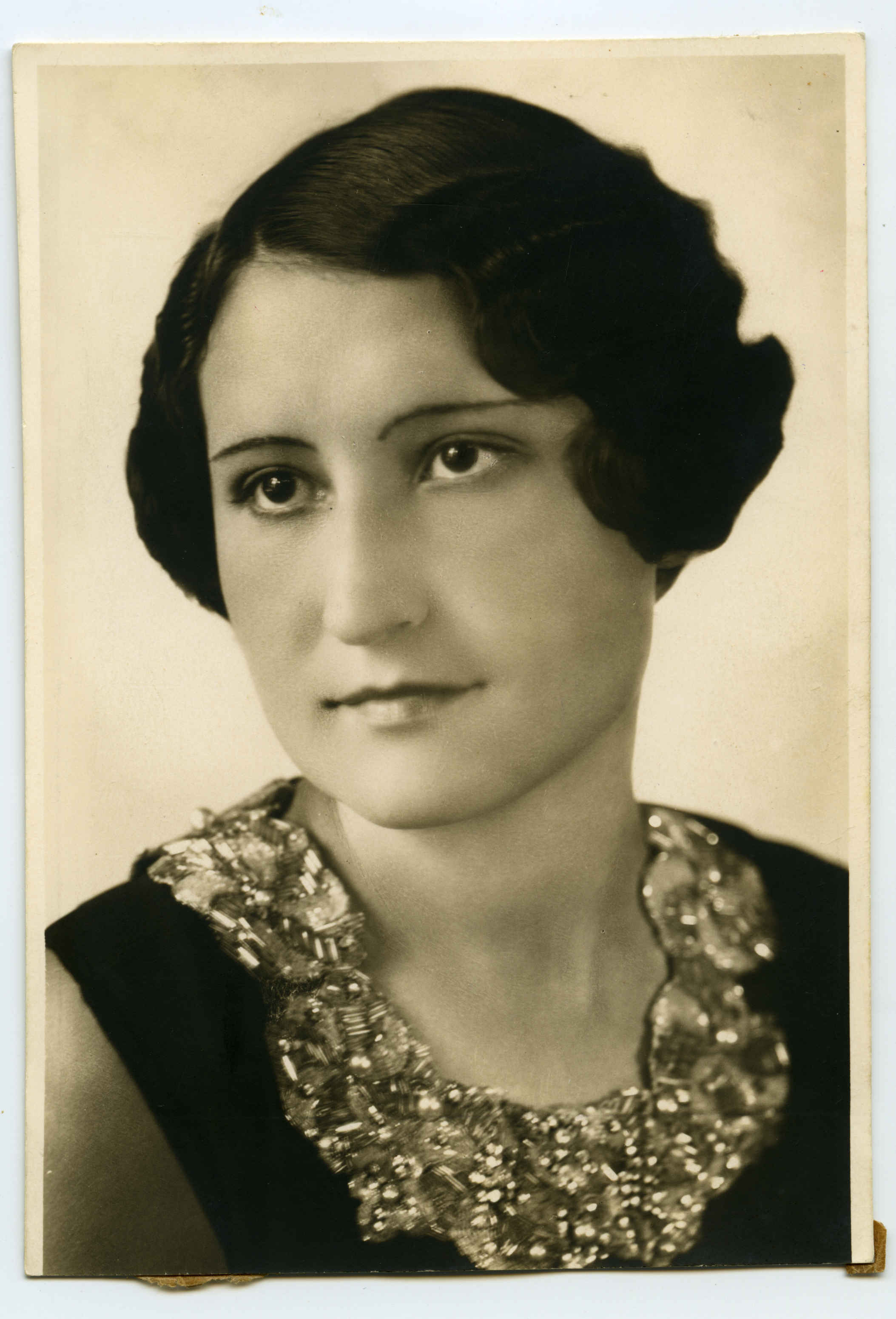
Leida Kibuvits
Leida Kibuvits (born Kupits; from 1948, her last name was Aisenstadt; 18./5. X. 1907 – 5. XII 1976) was one of the writers who emerged before the Second World War in Estonia, but whose life and creation were personally influenced by the war and Stalin era repressions.
She was born in Kurepalu, Tartu county, her father was a tailor and her mother a maid. Her childhood was spent in Tartu, near the river Emajõgi, where her parents moved to a few years later. She lost her father when she was 12. From 1913-1919, she studied at the German language Amalie Salomon Girls’ School in Tartu; from 1919-1927, at Tartu Girls’ Gymnasium and from 1922-1924, at Pallas art school as a student of Konrad Mägi. From 1927, she first worked as a pharmacist assistant, then as a printer. In 1929, she started work as a typist at the Ministry of Defense. There, she met lieutenant August Kibuvits (1904-1967), who she married in 1931. In 1938, their daughter Kai was born (died in 1983).
From 1933-1944, she was a professional writer and lived in Pärnu (where she was also a dramaturge at Endla theater) and Viljandi. She wrote both short stories and novels, and translated foreign literature, for example Goethe and Zweig. As an educated artist, she also illustrated two of her books (the story collection Rist ja rõõm (‘Cross and Joy’) and the novel Kass arvab, et… (‘The Cat Thinks That…’). In 1932, she won the Loodus publishing house’s novel competition with her book Soomustüdruk (‘Armored Girl’) and in 1940, came first at the Sirp ja Vasar newspaper short story competition with her story Väike kivi (‘Small Stone’). From 1938, she was a member of the Estonian Writers’ Union and from 1945, a member of the Soviet Estonian Writers’ Union.
In 1940, the family moved to Pechory due to August Kibuvits’ job. After working for the Home Guard (Omakaitse, which existed during the Nazi occupation in Estonia from 1941-1944), he went missing and was declared deceased when Leida requested a divorce in 1943. Years later it was revealed that August had fled to Canada, leaving his wife and daughter behind, and married another Estonian woman called Luise. In 1944, Leida Kibuvits found employment as the head of the culture department of the newspaper Rahva Hääl – a position she held for two years. In 1946, she received a medal “For Valiant Labor in the Great Patriotic War 1941-1945”. In 1948, she married the communist Leo Aisenstadt (1912-1975), likely for political reasons.
In 1950, she was arrested and accused of publishing anti-Soviet publications during the German occupation in 1942 and for working with the Germans. She was deported to Solikamsk in Siberia. From her original 25-year sentence she served four, then was able to return home in very poor health. Allegedly it was the renowned writer Aadu Hint who helped her be released but pardon pleas were sent by both her mother and her daughter. In 1962, she got an apartment in the Tallinn Writers’ House where she supposedly painted all the ceilings orange. The end of her life was spent in poverty and solitude.
Her works address fighting for dignity and against hardship. They offer influences from the Estonian epic Kalevipoeg, an insider’s perspective on theater life of the era and an attempt to see the world through a cat’s eyes. Her family saga Leinapajud (‘Weeping Willows’) was left unfinished.
Kibuvits has translated into Estonian Goethe’s ‘Wilhelm Meister’s Apprenticeship’ (1958) and ‘Wilhelm Meister’s Journeyman Years’ (1959), also short stories by Stefan Zweig. She was also very talented in needlecraft.
Kibuvits was crushed in the grip of totalitarianism during the Soviet occupation and has, as a result, been largely forgotten in Estonian literary history. In this century, there have been attempts to revive her life and work both with an exhibition at A. H. Tammsaare museum (2010-2011) and with the book Leida Kibuvits. Kirev. Saatus ja looming (‘Leida Kibuvits. Colorful. Fate and Creation’), which contains articles on her life and writings and a cross-section of her most important works.
Leida Kibuvits is buried at Metsakalmistu in Tallinn.
M. K. (Translated by A. S.)
Books in Estonian
Novels
Soomustüdruk. Tartu: Loodus, 1932, 240 lk. [2., tugevalt muudetud trükk: Tallinn: Eesti Riiklik Kirjastus, 1957, 448 lk; 3. trükk: Tallinn: Eesti Raamat, 1986, 415 lk.]
Rahusõit. Tartu: Loodus, 1933, 207 lk. [2. trükk koos romaaniga ‘Manglus Sepapoeg’: Tallinn: Eesti Raamat, 2003, 304 lk.]
Paradiisi pärisperenaine. Tartu: Loodus, 1934, 239 lk.
Manglus Sepapoeg. Tartu: Noor-Eesti Kirjastus, 1936, 232 lk. [2. trükk koos romaaniga ‘Rahusõit’: Tallinn: Eesti Raamat, 203, 304 lk.]
Kass arvab, et…. Tartu: Eesti Kirjastuse Kooperatiiv, 1936, 212 lk.
Short Stories
Rist ja rõõm. Tartu: Eesti kirjastuse Kooperatiiv, 1938, 366 lk.
Sipelgaõli. Tartu: Ilukirjandus ja Kunst, 1941, 160 lk.
Elagu inimene!. Tallinn: Eesti Riiklik Kirjastus, 1962, 336 lk.
Lepatriinupunane. Koostanud Linda Uustalu. Tallinn: Eesti Raamat, 1987, 264 lk. [Novellid. Sisu: ‘Lugu Püha Gertrudi säilmest’, ‘Boorvaseliini-Helmi viimne armastus’, ‘Rist ja Rõõm’, ‘Harak-Mihkel’, ‘Sipelgaõli’, ‘Lepatriinupunane’, ‘Viimased võõrad suled’, ‘Väike kivi’, ‘Medaljon’, ‘Teine tee’, ‘Punane liilia’, ‘Julge mees – kaks korda…’.]
Children’s Literature
Kaks meest on ikka kaks meest. Tallinn: Ilukirjandus ja Kunst, 1947, 148 lk.
Tuljak ja Tups. Tallinn: Ilukirjandus ja Kunst, 1948, 204 lk.
Collections of novel excerpts and short stories
Endistest aegadest. Valik proosat aastatest 1934-1941. Koostanud Asta Hameri. Tallinn: Eesti Raamat, 1977, 487 lk.
Leida Kibuvits. Kirev. Saatus ja looming. Koostanud Sirje Endre. Tallinn: SE&JS, 2017, 224 lk. [Sisaldab ka: Maarja Vaino, ‘Saateks’, Kadi Pajupuu, ‘Leida Kibuvits illustraatorina’, Anu Raud, ‘Leida Kibuvitsa igavene elu’.]



